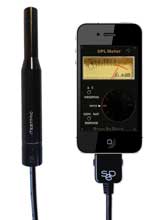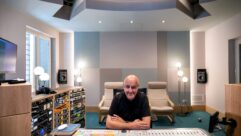

Studio Six Digital iTestMic Review
Nov 16, 2012 2:37 PM,
Reviewer: John McJunkin
A test mic with a plethora of features and a la carte options.
This is the year of the “i” device. As smart phones and tablet devices continue to march on toward complete world domination, millions and millions of people all over the planet are discovering the truly incredible power of having the physical hardware of a computer and communications device, with the capacity for nearly limitless uses via myriad software apps. There are apps to accomplish, or to at least help accomplish, nearly any task imaginable. Apple’s iPad has become a popular remote graphical user interface for mixing and tweaking the parameters of a sound reinforcement system, but one of its most popular applications is the mixing of one’s own monitor mix by musicians, vocalists, speakers, and actors on stage. It should be quite clear that tablet devices and smart phones will quickly become very popular tools for audio system control and monitoring, among numerous other production-oriented uses. As a sound professional, I can only imagine how thrilled the lighting folks must be with these things. Aside from realtime parameter tweaking, mixing, and monitoring of system operations, the computer contained within these devices is powerful enough to offer the audio professional the capacity to gather high-resolution measurements—for instance, SPL, realtime analysis, delay measurement, signal generation, among other things. Studio Six Digital has developed a calibrated test microphone known as the iTestMic, and an iPhone app that features a suite of audio tools that are eminently useful to the audio pro. I evaluated one, and I was very impressed.
The iTestMic, available exclusively at audiocontrolindustrial.com, retails sells for $199.95, and eliminates the need for any kind of audio interface, mic preamplifier, or A/D conversion; all three of these items are built in to the body of the test mic itself and it’s surprisingly compact—just 5 1/2in. long and 3/4in. in diameter over most of its length, but 1/2in. in diameter at the business end. The preamp offers two overlapping gain ranges so you can handle a broad range of signals. The mic itself meets ANSI/ISO Type 2 specs in terms of frequency response, linearity, and directional characteristics. It would be impossible for it to meet Type 1 specs because in order to do so the mic must be evaluated together with it’s associated measurement device. In other words, there’s no such thing as a microphone that meets Type 1 standards; only combined mic/measurement device systems can meet the spec. Bottom line here, this is a serious professional test mic with built-in hardware to bypass the difficulties inherent to introducing a signal to a smart phone or tablet device via the manufacturer’s non-professional interface.
Once you get your signal into your smart device, you can measure numerous attributes and characteristics of that signal. Studio Six Digital has made the AudioTools app available, and it consists of a suite of nine measurements and processes that are useful with the iTestMic input—a Swiss Army Knife kit with the measurements and functions most commonly wanted by audio pros. I focus in this review exclusively upon functions and additional in-app purchases that require no other hardware aside from the iTestMic or the internal mic of the smart device. First there is the SPL Meter, offering accurate sound level metering and weighting capabilities. Specifically, A and C weighting are available, and the “ballistics” of the virtual analog meter can be switched between fast or slow. And the large rotary switch determining range as seen on physical SPL meters is also approximated in the app. The meter can be calibrated, and also offers compensation for your smart device’s internal mic if you need to use it.
The realtime analysis feature (RTA) offers both third-octave and full-octave frequency resolution, adjustable display decay modes, peak hold, and average, which displays a continuous equal-weighted average for each frequency band. The power of the gesture-oriented graphical user interface of the smart device really shines in the RTA display, facilitating the simple adjustment of range by sliding the graph up or down with a finger, and scaling, which is accomplished by pinching. Snapshots of the curves can be grabbed and stored, emailed, or transferred to a computer with a third-party app. Noise curve overlays can be employed, and overall, full-bandwidth SPL is displayed as well. I find this to be an incredibly powerful tool, useful for room tuning and just getting an overall handle on the spectral energy dispersion of any given system.
The Audio Scope is exactly that, a dual-trace, audio-band oscilloscope and is arguably one of the most useful audio tools. There is also the Generator that creates sine and square waves, along with white and pink noise, both of which can be octave-band limited, and sweeps can be set up as well. The Generator output is very accurate and distortion-free, created with 64-bit floating-point math. Monitor simply monitors the mic input with headphones. The Recorder function does exactly that, up to 24 hours in duration, mono or stereo, and in WAV, Apple CAF, or AAC formats, with a sample rate of 8kHz, 22.05kHz, 44.1kHz, or 48kHz. Studio Six has licensed iZotope plug-ins for use with this feature as well. An audio-oriented Calculator is also available, including dB conversions, SPL addition, and room mode calculation, among others. Finally, AudioTools offers file export and calibration of all inputs and outputs.
Beyond the basic instruments available in AudioTools, Studio Six Digital makes more sophisticated functions available as in-app purchases as well. The pricing of these modules represents a high degree of value, considering the additional capacity each adds to a contractor or integrator’s toolkit. There is Fast Fourier Transform (FFT) for really detailed audio analysis well beyond simple RTA. The SPL Pro module is a fuller-featured version of the basic SPL app, with impulse, peak, and Leq modes, and octave band filters. It also offers a numerical display as opposed to the traditional analog meter of SPL. SPL Graph offers graphing of SPL over time, up to 24 hours, typically for noise studies, among other things. The SPL Traffic Light shows large, obvious red, yellow, and green circles on the display, corresponding to levels set by you, typically for monitoring of levels for venue compliance in higher-SPL applications. ETC, or energy time curve, simply creates a graph of the decay of an impulse, showing the decay time of an acoustical space. Impulse Response allows the recording and analysis of impulses. Speaker Polarity displays exactly what its name implies. The Speaker Distortion module measures the distortion created by a loudspeaker. The Smaart Tools Single Channel Module brings much of the exceptional functionality of Smaart 7 to your iPhone or iPad, with the convenience of gesture-oriented graphical user interface functions, which I find very powerful. The VU Meter module is just a simple analog-type VU meter. Finally, there are two versions of STI-PA (basic and pro), which measure speech intelligibility for paging and public address, typically to meet minimum fire safety codes.
Even with just the basic suite of measurement devices available in AudioTools, professionals should be able to accomplish quite a bit. And since the advanced modules are available for purchase a la carte, a person can build a nice suite of powerful tools over the course of time. It seems like every time I turn around, I find another powerful use for smart devices in the domain of audio, and it’s no surprise—this is the sort of thing that the visionaries imagined. And in consideration of the very reasonable price for the iTestMic itself, this package is something I recommend for every audio pro to very strongly consider if they’re serious about their craft.
PRODUCT SUMMARY
Pros: Versatile, feature-laden, excellent value
Cons: Smart device must be in close proximity to mic due to the short cable.
Applications: Any pro audio situation in which accurate measurements of various audio-oriented phenomena metrics are necessary.
Price: $199.95 (iTestMic); $9.95-19.95 (AudioTools Basic); In-app modules prices vary per module
SPECIFICATIONS
Pattern: Omnidirectional
Frequency Response: 20Hz – 20kHz ± 3dB
Gain Range: 28dBA – 120dBA (in two ranges); 28dBA – 105dBA and 48dBA – 120dBA
Dimensions: 5.5”x 0.5”x 0.5” (length x tip diameter)
Power Consumption: <50mA
John McJunkin is the principal of Avalon Podcasting in Chandler, Ariz., and produces and co-hosts a top-rated morning radio talk show in Phoenix. He has consulted in the development of studios and installations and provides high-quality podcast and voice production services.










